While ecommerce might be seeing a surge in the coronavirus economy, skyrocketing unemployment rates and unpredictable consumer demand make it difficult to feel stable in any industry. And in times like these, it’s more important than ever to run a tight ship in regard to your expenses.
Shipping is what allows us to continue to do business, as retail stores are forced to close for the foreseeable future. But it’s also a necessary evil. It sure as heck doesn’t come free.
In fact, shipping costs are the biggest challenge for more than half of online sellers. If you want to know how to reduce your shipping costs and save some of that cash to more comfortably weather this storm, here are some ways to do exactly that.
Post Contents
- Work With Multiple Suppliers
- Nurture Supplier Relationships
- Negotiate Rates
- Know Your Shipping Options
- Set Default Shipping Methods
- Prioritize Countries With Affordable Shipping Rates
- Choose the Right Platforms
- Minimize Packaging
- Charge More for Your Products
- Try Longer Delivery Windows
- Conclusions on Saving on Shipping
- Want to Learn More?



Work With Multiple Suppliers
There’s no rule in dropshipping that you have to give all your business to one supplier. In fact, diversification is an excellent strategy for finding the best products at the best prices. The same rings true when it comes to shipping costs.
Lots of products are available from more than one supplier. You might find a product to sell from Amazon that’s also available from AliExpress and SaleHoo. So if the product is right, but the shipping price isn’t, don’t be afraid to shop around to snag a better deal and increase your ROI.
→ Click Here to Launch Your Online Business with Shopify
This is also a sound strategy in today’s economy. With coronavirus hitting factories and warehouses, and governments constantly updating what is deemed “essential business,” your suppliers could face a halt in production at any time. When you have a diversified supplier pool, you can tap into one of your other resources if one of your other suppliers is out of commission.
Nurture Supplier Relationships
As the COVID-19 pandemic hits every corner of the world, we’re in a unique situation in which every person across the globe is facing the same “challenge” and seems to be taking on a “we’re all in this thing together” kind of mentality. Relationships are becoming more important than ever before.
Successful business is built on strong relationships. And we’re not just talking about your customers, business partners, or even employees (though they’re important, too). We’re also talking about vendor relationship management.
Suppliers are a critical part of every dropshipping business. Without them, you wouldn’t have anything to sell. Literally. So you want positive working relationships that foster open communication and collaboration. Reach out to your suppliers, and ask how they’re doing during this time. See if there’s anything you can do to help them get through any bumps in the road.
Now, what does being friendly have to do with shipping costs?
Open dialogue allows you to more easily broach the subject of shipping costs in the first place. Having a good rapport will make suppliers more likely to trust you and open to new ideas on how to optimize these fees in a way that’s mutually beneficial.
Now, merchants and suppliers can work alongside instead of parallel to one another. “Make sure that you’re entering into a partnership, not a transactional relationship,” says Bradley Day of HELM Boots. “The days are gone where the relationship consists of accounts buying and brands selling.”
Together, you can brainstorm ideas to minimize packaging, get better rates from carriers, or source from different fulfillment locations if available.
Negotiate Rates
Speaking of vendor relationships, sometimes you have to put your business hat on and hit the negotiating table.
If the thought of negotiating makes your palms sweaty, the Harvard Business Review gives us four ways to gain the upper hand – with No. 1 being the most risk averse and No. 4, the most risky. Ask yourself the questions associated with each. If you answer no to both, you can afford to take on a bit more risk.
1. Bring new value to the supplier (low risk)
- Can we help the supplier enter new markets or industries?
- Can we help the supplier reduce its business risk?
2. Change how we buy
- Can we gain leverage by consolidating orders or by bundling/unbundling product or service packages?
- Do we really need everything we’re buying?
3. Create a new supplier
- Are there potential entrants in adjacent markets?
- Can we vertically integrate to become our own supplier?
4. Play hardball (high risk)
- Can we afford to withhold or cancel orders?
- Do we have grounds for litigation?
Put your supplier relationships and negotiating skills to the test by talking about your goal to optimize shipping fees and asking about the options. Maybe you can talk your supplier into a discount in exchange for a monthly order minimum. Or maybe you can convince them to take on more of the shipping costs themselves. There are lots of ways you can negotiate lower shipping costs with your suppliers.
Know Your Shipping Options
Just like there’s a whole sea of suppliers out there, there are different shipping options to choose from.
- USPS and other national carriers
- ePacket shipping
- AliExpress Standard Shipping
- Free on Board (FOB) shipping
USPS and Other National Carriers
USPS, China Post, Royal Mail – these are some of the national carriers available to dropshippers. And they completely vary in cost, delivery time, and tracking. China Post, for example, might take 20 to 50 days worldwide, while USPS can deliver in just two to15 days, but is limited to the U.S.
The important thing to note is that these change. And, yes, it might be overwhelming to research the cheapest carrier for every product for every destination – but that is the only way to know you’re paying as little as possible to fulfill every order.
ePacket Shipping
And then we have ePacket shipping, which is available in more than 40 countries for products sourced from China and Hong Kong. ePacket shipping offers affordability as well as an extra layer of reliability with built-in tracking.
Like FOB shipping, ePacket isn’t always the most affordable. It also isn’t always the quickest – packages take anywhere from about two weeks to a month. But it’s reliable and, in many cases, affordable.
Ultimately, you want to look at all your options, the associated costs, and other pros and cons like delivery time, tracking, and more.
AliExpress Standard Shipping
If you’re dropshipping from AliExpress, you can use their shipping option as well. AliExpress Standard Shipping is typically low-cost – sometimes free – and delivers packages across the globe between 15 and 45 days.
Free on Board (FOB) Shipping
Free on Board (FOB) shipping is when the seller records the sale the instant the goods leave their warehouse, while the buyer waits to record the purchase only after they have both received and accepted the shipment at their warehouse, the destination. Should there be an issue with the shipment, the responsibility lies on the buyer to file a claim for any damages, etc.
This all sounds like the buyer is the one responsible for paying shipping costs, and that’s true. But there is a cost-saving benefit here: You can choose the warehouse that offers the most affordable shipping options. This might be because of location, shipping method, or other reasons. Find out your FOB shipping costs, and compare for each location.
Note: The shipping options above aren’t all of the shipping options at your disposal. They’re just some of the more popular, affordable solutions.
In the example below, we have Yanwen Economic Air Mail, Cainiao options, and Singapore Post – along with ePacket, DHL, etc. For shipping to customers in the U.S., the cheapest option is Yanwen Economic Air Mail.
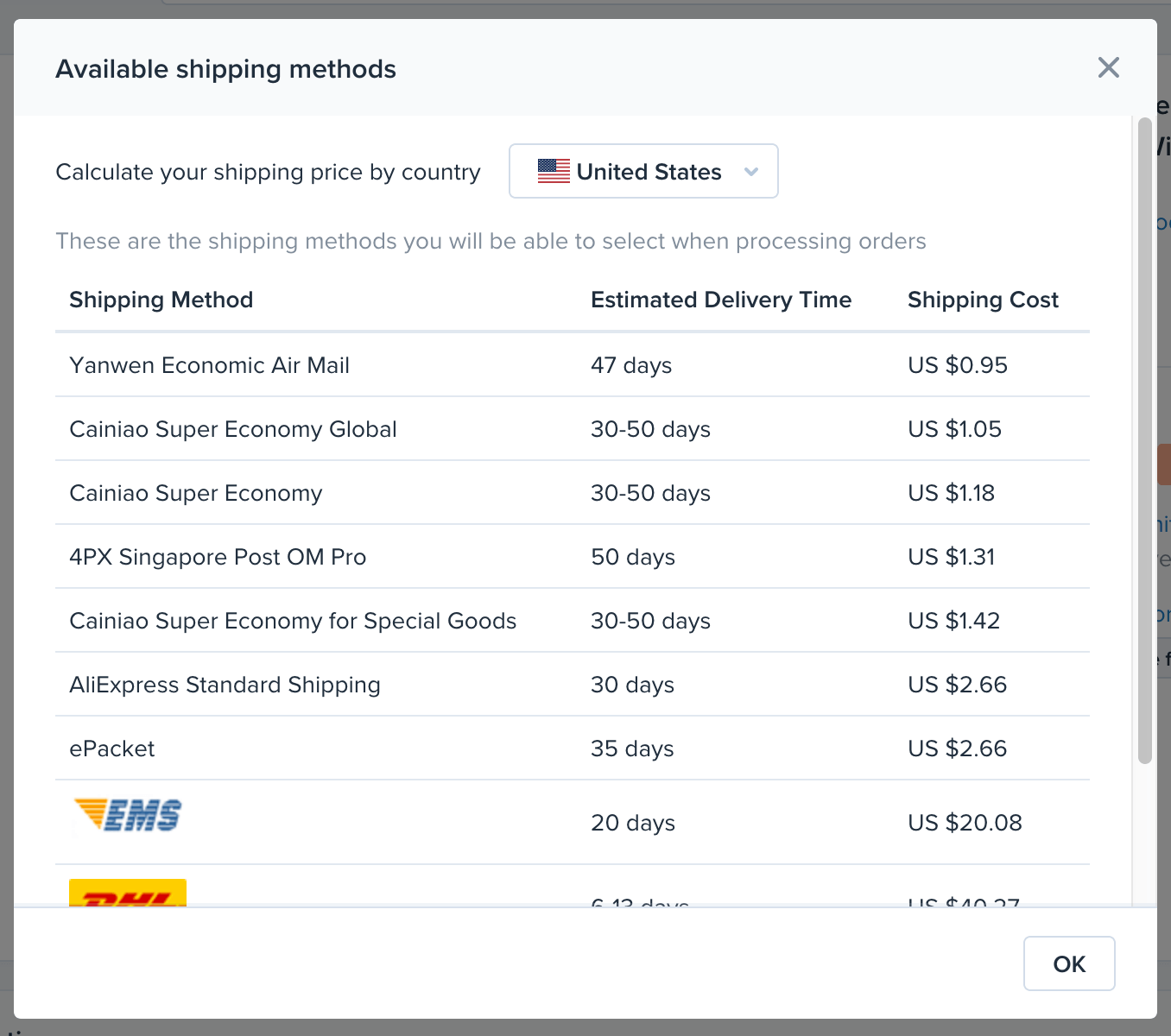
But what does it look like for a customer in Singapore? Here, it makes sense to go with the local carrier – Singapore Post.
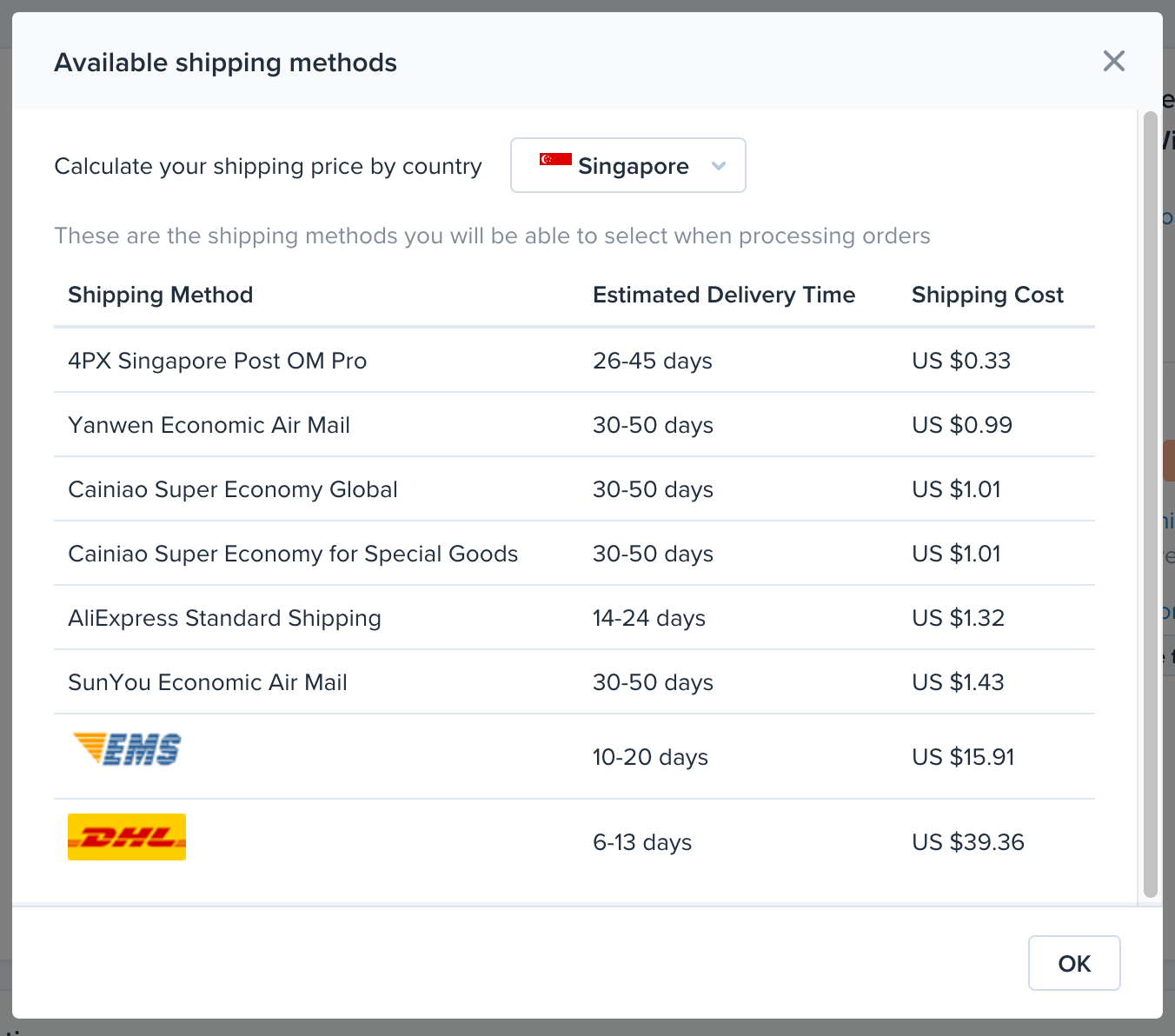
The cheapest shipping option is almost always circumstantial.
Set Default Shipping Methods
All of this sorting through shipping costs and methods and options can be a lot of work. But here’s the easy part: You can customize shipping settings for each individual supplier.
So, let’s say one supplier offers the best shipping rates via ePacket. You can choose to ship all of their orders via ePacket. However, a different supplier actually offers free AliExpress Standard Shipping. So you’ll want to assign that shipping method to all orders from that supplier.
This takes a lot of the manual processes out of it. You can set it and forget it, and only check back when you want to reassess your shipping expenses.
This way, orders for those products will automatically be routed the most cost-effective way.
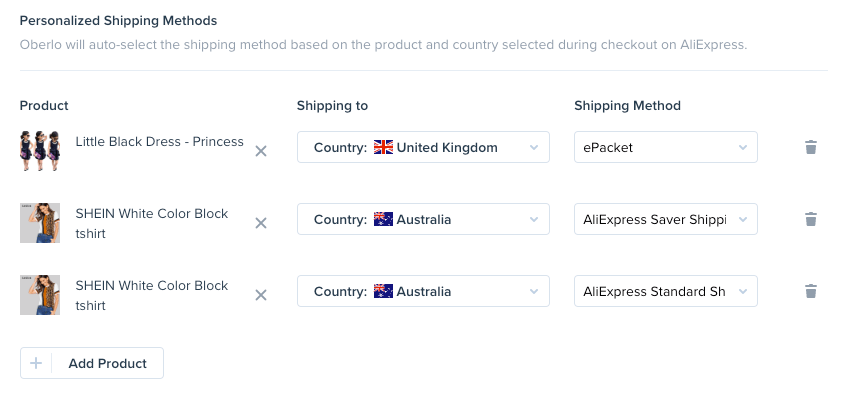
Prioritize Countries With Affordable Shipping Rates
Ecommerce is awesome because you can reach a global audience. There are no boundaries … until you have to ship the products to customers.
International shipping comes with its own set of regulations and requirements – and costs. Shipping fees vary depending on the origin and destination locations.
Here’s an example, with prices for shipping to the U.S.:
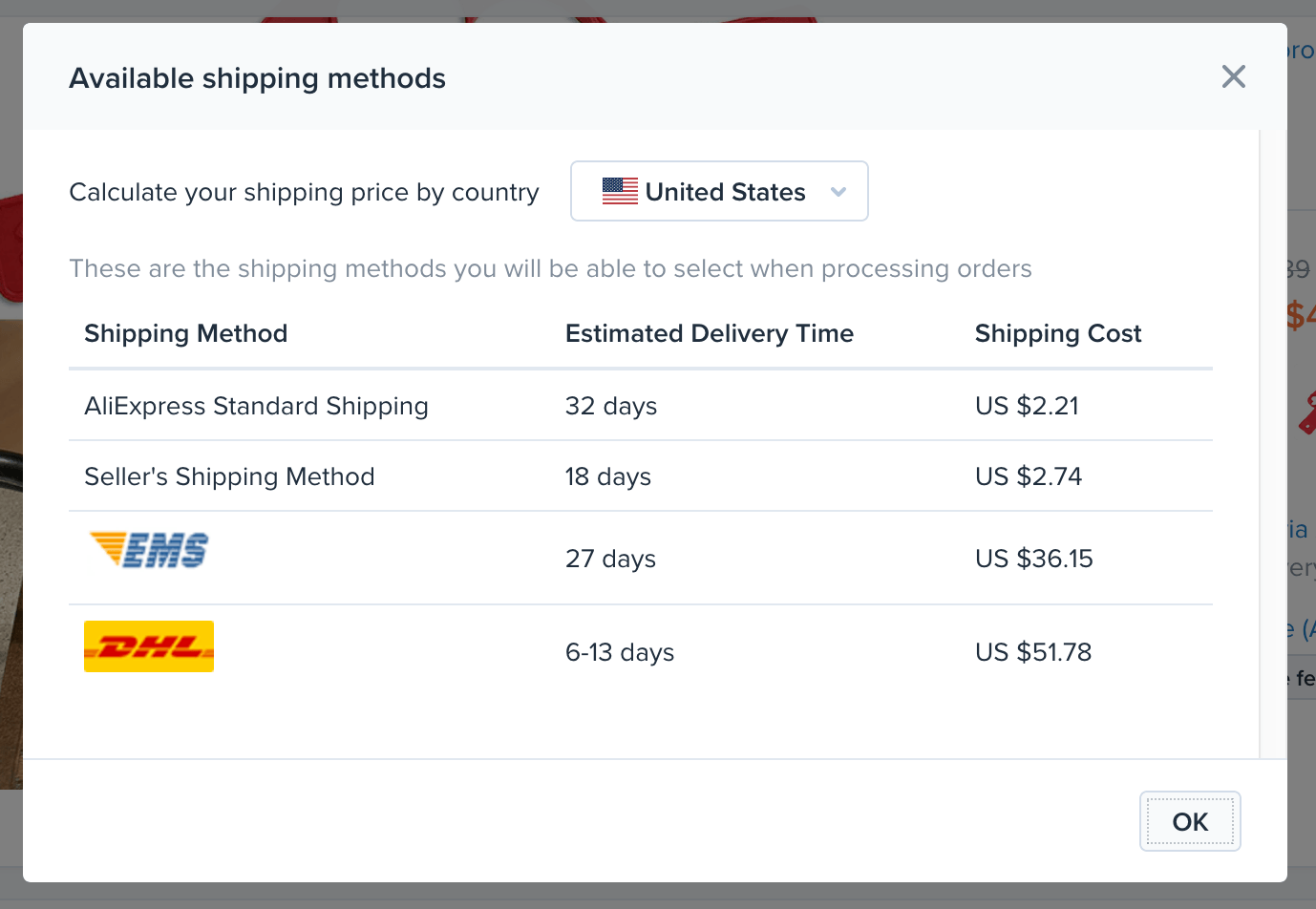
Compared to Canada:
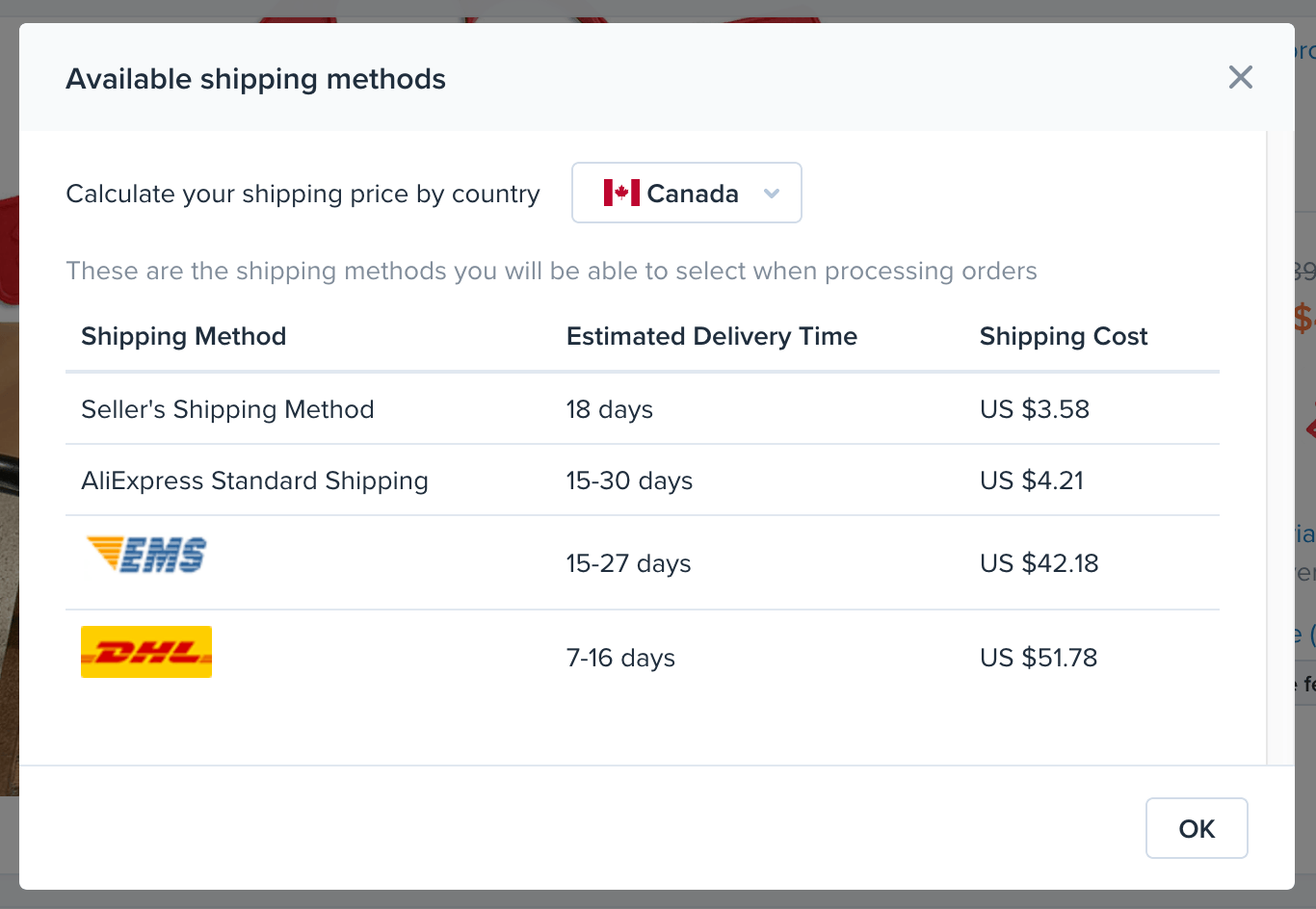
Here, it’s more cost-effective to ship these products to the U.S. instead of Canada. As such, you’d want to target that geographic location if you want lower shipping costs.
On your advertising platforms, select the audience that’s located in the countries where it’s cheapest to ship. There’s no reason to waste ad dollars on a region you don’t want to pay to ship to.
Or, if you want to focus on a specific region, search various suppliers to see who can offer the most competitive pricing for that location. Remember: Working with multiple vendors typically benefits you, the merchant.
Compare multiple countries to see where you can generate the highest ROI after accounting for shipping fees.
Use Custom Shipping Zones
Set up shipping zones with different rates to help reduce your out-of-pocket shipping costs. Once you know how much it costs to ship to each country, you can adjust the customer’s shipping costs depending on their location.
Designate free shipping to areas where it’s more affordable, and charge a bit more for other places.
Pro tip: Let customers know that free shipping is only available in select locations. And if it’s only available in one country, say so up front. Remember, shipping costs can lead to more cart abandonment, so you don’t want to surprise anyone during checkout.
On Shopify, you can do this in your Shipping settings page. Simply add the countries you want in your free shipping zone, and allocate the rest to different shipping zones with their corresponding rate. This will automatically adjust the shipping cost at checkout depending on the product’s destination. (Yay for automation!)
Choose the Right Platforms
Some ecommerce platforms give merchants access to discounted shipping rates with international carriers. Shopify deserves a shout out for this: They’ve negotiated rates for merchants based in the U.S. and Canada for shipping with USPS, UPS, DHL Express, and Canada Post.
Shipping software providers also negotiate rates directly with carriers and then pass those discounts onto merchants.
Minimize Packaging
Two sure ways to make your shipping costs go up? Size and weight. The bigger and heavier your package, the more you’re going to pay to get it to its destination.
Opt for minimal product packaging. You’ll want to make your packages as small as they can be (while still protecting the products inside) and weigh as little as they possibly can. Now, if you’re shipping something like books, you might not have a lot of options for lightweight packages. But what you can control is the packaging itself.
But this can cost money, too! Here’s where freebies come into play.
Many shipping companies offer free boxes and materials for merchants to use. Get more info straight from the source:
Charge More for Your Products
Nobody likes to pay for shipping. And consumers don’t just want free shipping – they expect it. One study from the National Retail Foundation (NRF) found that three-quarters of consumers believe shipping should be free, even on low-value orders.
So, when you tack on a shipping fee, consumers get sticker shock. And this is not the place to rub them the wrong way. They’re already interested in your products enough to put them in their shopping cart and move through the checkout process. Introducing an unexpected shipping fee is a quick way to lose a sale and piss off a potential customer.
The idea here is to raise your prices – just enough, not too much – to cover your shipping costs. While this isn’t technically money-saving, it is an effective way to keep more of your profits and lower cart abandonment.
Try Longer Delivery Windows
With Amazon ingraining two-day shipping as the norm – and platforms like Instacart and Shipt upping the ante with same-day delivery – today’s consumers are used to instant gratification. But not every online shopper needs expedited delivery. Many are willing to wait a bit longer for the perfect item.
The longer you give a carrier to deliver a package, the more inexpensive it typically is. That’s why we pay an arm and a leg for overnight delivery and why Amazon incentivizes longer delivery time. It’s easy to take advantage of the free credits Amazon offers for digital content. After all, what’s an extra couple of days?
Give your customers a heads up that delivery might be a while and offer them the option to pay for expedited delivery themselves. Nearly a quarter of customers opt for four- to seven-day shipping anyway.
A word of advice: If the delivery window is 15 to 25 days, tell customers it’ll be 20 to 25 days. A big window may seem unrealistic. And who’s going to complain that you got their shipment to them too quickly?
Conclusions on Saving on Shipping
Shipping costs are a pesky expense that can cut into your bottom line. With a little time and research, you can lower these costs and reinvest more of that money into your business.






